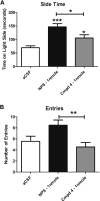Identification of the first biased NPS receptor agonist that retains anxiolytic and memory promoting effects with reduced levels of locomotor stimulation
- PMID: 28267583
- PMCID: PMC5414581
- DOI: 10.1016/j.neuropharm.2017.03.001
Identification of the first biased NPS receptor agonist that retains anxiolytic and memory promoting effects with reduced levels of locomotor stimulation
Abstract
The neuropeptide S system has been implicated in a number of centrally mediated behaviors including memory consolidation, anxiolysis, and increased locomotor activity. Characterization of these behaviors has been primarily accomplished using the endogenous 20AA peptide (NPS) that demonstrates relatively equal potency for the calcium mobilization and cAMP second messenger pathways at human and rodent NPS receptors. This study is the first to demonstrate that truncations of the NPS peptide provides small fragments that retain significant potency only at one of two single polymorphism variants known to alter NPSR function (NPSR-107I), yet demonstrate a strong level of bias for the calcium mobilization pathway over the cAMP pathway. We have also determined that the length of the truncated peptide correlates with the degree of bias for the calcium mobilization pathway. A modified tetrapeptide analog (4) has greatly attenuated hyperlocomotor stimulation in vivo but retains activity in assays that correlate with memory consolidation and anxiolytic activity. Analog 4 also has a bias for the calcium mobilization pathway, at the human and mouse receptor. This suggests that future agonist ligands for the NPS receptor having a bias for calcium mobilization over cAMP production will function as non-stimulatory anxiolytics that augment memory formation.
Keywords: Anxiolytic; Biased ligand; Memory; Neuropeptide S.
Copyright © 2017 Elsevier Ltd. All rights reserved.
Figures







References
-
- Badia-Elder NE, Henderson AN, Bertholomey ML, Dodge NC, Stewart RB. The effects of neuropeptide S on ethanol drinking and other related behaviors in alcohol-preferring and -nonpreferring rats. Alcohol Clin Exp Res. 2008;32:1380–1387. - PubMed
-
- Bernier V, Stocco R, Bogusky MJ, Joyce JG, Parachoniak C, Grenier K, et al. Structure-function relationships in the neuropeptide S receptor: molecular consequences of the asthma-associated mutation N107I. The Journal of biological chemistry. 2006;281:24704–24712. - PubMed
-
- Black JW, Leff P. Operational models of pharmacological agonism. Proc R Soc Lond B Biol Sci. 1983;220:141–162. - PubMed
-
- Boeck CR, Martinello C, de Castro AA, Moretti M, Dos Santos Casagrande T, Guerrini R, et al. Blockade of adenosine A2A receptor counteracts neuropeptide-S-induced hyperlocomotion in mice. Naunyn Schmiedebergs Arch Pharmacol. 2010;381:153–160. - PubMed
-
- Camarda V, Trapella C, Calo G, Guerrini R, Rizzi A, Ruzza C, et al. Structure-activity study at positions 3 and 4 of human neuropeptide S. Bioorg Med Chem. 2008;16:8841–8845. - PubMed
Publication types
MeSH terms
Substances
Grants and funding
LinkOut - more resources
Full Text Sources
Other Literature Sources
Medical
Molecular Biology Databases

